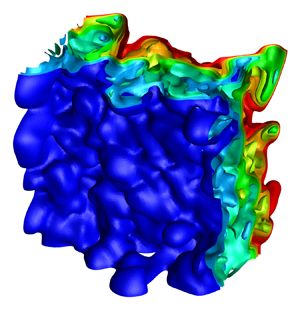Article contents
A new idea to predict reshocked Richtmyer–Meshkov mixing: constrained large-eddy simulation
Published online by Cambridge University Press: 11 May 2021
Abstract

The reshocked turbulent Richtmyer–Meshkov (RM) mixing of two media is the most representative problem of more general and complex turbulent mixing induced by interfacial instabilities, broadly occurring in both nature and engineering applications. An accurate prediction of its evolving of spatial structure and mixing width (MW) is of fundamental importance. However, satisfactory prediction with the large-eddy simulation (LES) has not yet been achieved, even for the most important MW. In this paper, we innovatively solve this problem by combining the idea of the constrained large-eddy simulation (CLES), which succeeded previously only in classical single-medium turbulence, and our recently developed Reynolds averaged Navier–Stokes (RANS) model, which realized a satisfactory prediction of MW. Specifically, in our currently developed CLES model, with the aid of Reynolds decomposition, the unclosed subgrid scale (SGS) LES model is decomposed into two parts, i.e. the averaged and the fluctuating. The averaged part is dominated and modelled by the counterpart of our recently developed RANS model to accurately predict the MW, while the fluctuating part is modelled with the classical Smagorinsky model. Consequently, besides successfully capturing the three-dimensional large-scale structure of turbulence and the evolution of the (normalized) mixed mass, our newly proposed CLES also predicts a satisfactory MW with a very coarse grid. To the best of our knowledge, this is the first time that the LES can yield such a comparable result with experiment.
- Type
- JFM Rapids
- Information
- Copyright
- © The Author(s), 2021. Published by Cambridge University Press
References
REFERENCES
- 15
- Cited by





